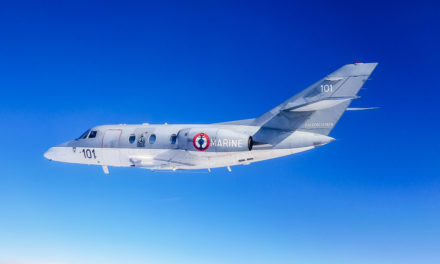The National Business Aviation Association (NBAA) annual convention, held October 22-24, 2019 in Las Vegas, once again delivered on all its promises.
Back to the highlights of this edition.
Since the beginning of 2019, the Association’s communication has focused on the use of green and sustainable energy by business aviation industry. After Ebace, the 2019 NBAA Convention & Exhibition has logically, as soon as the show opens, sensitized the various stakeholders on the environmental practices to adopt in this industry for years to come. In this spirit, the focus was on the use of bio fuel, the introduction of new technologies and the use of new materials.
Thus, among the aircraft presented on the static display, a dozen had been conveyed with “green” fuel.
To reinforce his message, NBAA President Ed Bolen opened the show along with former basketball player Earvin “Magic” Johnson. Today an entrepreneur, and a business aviation fervent defender and user, “Magic” Johnson explained that he was concerned about the ecological impact of this mode of transport and that he favored as much as possible the use of sustainable fuel. The famous basketball player recalled that the use of “bio fuel” reduced by 80% the carbon emissions in the atmosphere. This should lead, with the gradual introduction of new technologies, to new virtuous practices in a sector long considered as a polluter.
More programs to come
The enthusiasm associated with this new trend, however, did not influence the manufacturers their program strategies. On the contrary, the market focused on larger and larger aircraft.
In the top-of-the-line race that sees a new outsider each year, Gulfstream has launched the G700, a new ultra-long range jet that will compete with Bombardier’s Global 8000 and undoubtedly with the future Falcon 9X that Dassault Aviation could officially launch in 2020. Embraer could also folow the trend by announcing a version of the Praetor (700 or 800), a wide cabin and long range model, currently absent from its catalog.
In the super-midsize business jet range, again, the manufacturers are not left behind. The Praetor 600, now in service, could be challenged by two new aircraft, one from Bombardier and the other from Gulfstream.
In the light and entry-level category, three new jets under study could emerge in the medium term: a new Citation CJ as well as extrapolations of Phenom 300EV and HondaJet.
Incredible G700
For a few months, we have been waiting for the imminent launch of the G700. It is therefore no surprise that the Savannah, Georgia-based manufacturer has announced its new flagship, expected firmly by professionals. With this jet, Gulfstream is once again going upmarket but above all, is tackling the new Bombardier Global range.
According to its predicted performance, the G700 should outclass the Canadian aircraft and establish itself as the largest business jet ever developed. To power the G700, Gulfstream has remained faithful to Rolls-Royce which has developed the all-new, high-thrust Pearl 700. Equipped with this engine, the G700 can fly 7,500 nautical miles/13,890 kilometers at Mach 0.85.
The 2500 plus cubic feet G700 cabin can accommodate up to 19 passengers with up to five living areas, an extra-large ultragalley with a passenger lounge or crew compartment, a six-place dining or conference room and a master suite with shower. The Gulfstream Cabin Experience promotes and enhances wellness through 20 Gulfstream panoramic oval windows, the largest in the industry. Moreover, a circadian-based moodlighting system will mitigate the jet lag effects.
The G700 Symmetry Flight Deck comes standard with Gulfstream’s Enhanced Flight Vision System and Synthetic Vision on dual head-up displays. Such a configuration has already been extensively tested on the aircraft manufacturer’s current range and the G700’s design benefits from more than a decade of research and development on the G650ER and G500 / 600 programs. This allows the aircraft manufacturer to judiciously announce that the program has already accumulated more than 14,000 hours of laboratory testing and successfully completed ground vibration tests, engine bench tests and structural tests. Two of the five prototypes planned are already assembled and the first flight of the aircraft is expected by Gulfstream to be imminent. The aircraft manufacturer counts for a delivery of the first aircraft by 2022.
Two launch customers have already been announced for this $75 million aircraft: Flexjet and Qatar Executive, which has ordered ten aircraft.
A new PC-12
Pilatus announced the launch of a new version of its PC-12, whose more than 1,700 units have been already sold. Dubbed NGX, this variant will be equipped with the new Pratt & Whitney PT6E-67XP engine which is 10% more powerful than the previous PT6 turbine. This improved engine features an Electronic Propeller and Engine Control System including Full Authority Digital Engine Control (FADEC) – a worldwide first in this market segment. The new propeller low speed mode results in a significant reduction in cabin noise for great passenger comfort. The new turboprop engine enables the PC-12 NGX to achieve a maximum cruise speed of 290 KTAS (537 km/h).
The Advanced Cockpit Environment (ACE™) System by Honeywell as inspired by the PC-24 is fitted on the PC-12 NGX and provides enhanced avionics. The digital autothrottle, i.e. automatic thrust adjustment, reduces pilot workload for greater safety and ensures automatic power optimisation in every phase of flight.
In addition to these technological improvements, the completely redesigned cabin now comes in six different BMW Designworks’ interiors. In addition, the cabin windows have been enlarged by ten percent to enhance the PC-12 NGX’s passenger experience and deliver more natural light. With the PC-12 NGX, priced at $ 4.39 million, Pilatus wants to demonstrate that its single-engine turboprop with reduced operating costs, remains an undisputed leader in its class, able to compete with Textron Aviation’s future Denali.
At the launch of the PC-12 NGX, the Swiss manufacturer also announced that three aircraft had already been ordered by customers from Australia, the United States and Brazil.
The Falcon 6X program on the right track.
Dassault Aviation gave an update on the highly anticipated Falcon 6X. The manufacturer indicated that the front, main and rear fuselage sections of the first aircraft have been completed and assembled at Dassault’s factory in Biarritz, France. The wing, currently being assembled in nearby Martignas, is due to be joined to the fuselage at Dassault’s Bordeaux-Mérignac facility early next year..
“Everything has been proceeding according to plan. The design was frozen earlier this year and the manufacturing process is well underway,” said Eric Trappier, Chairman & CEO of Dassault Aviation. “Dassault Aviation and our global partners have the collaborative digital tools in place to continue to meet the benchmarks that were established when the program was announced.”
Main aircraft systems including Honeywell third-generation EASy III all-digital avionics, hydraulic, braking, air, water, and electrical systems are being validated on a multi-system test bench in Istres, near Marseille.
Development of the Falcon 6X’s Pratt & Whitney Canada PW812D engine is also proceeding on schedule. The production PW812D together with the integrated nacelle will be mounted on the Pratt & Whitney Canada Flying Test Bed for the next upcoming flight test campaign.
More range for the Global 5500
On the static display, Bombardier introduced the newly certified Global 6500 and announced the updated performance of the Global 5500, also certified shortly before the show. The Global 5500 performance exceeded the expectations of the manufacturer. In particular, after further tests, the initial range of 5700 nm has been increased by 200 nm. The aircraft can now fly nonstop between Western Europe and the west coast of the United States at Mach 0.85.
Flexjet stands out
The global leader in fractional private jet travel, announced that it has placed a $1.4 billion order with Embraer Executive Jets for the Praetor mid- and super midsized aircraft and Phenom 300 light jets. This contract includes the conversion of the initially planned Legacy 450s into Praetor 500s. The American operator, which has a current fleet of more than 70 Embraer aircraft, received its first Praetor 500 early November 2019.
Flexjet also announced the same day it had placed an order to be the North American launch customer for the Gulfstream G700.
HondaJet converts to Medevac
Honda Aircraft Company displayed a mock up of the first medevac configuration on the HondaJet Elite. This sector seems promising for the aircraft manufacturer who installed this medevac configuration on a HondaJet Elite owned by Wing Spirit, an air ambulance and charter company based in Hawaii.
Meanwhile, the Honda Aircraft Company support and training network network continues to grow. The manufacturer announced it has named flyADVANCED as new service center, based in Wilmington, Delaware.
As the fleet grows, to cope with the increased demand for training, Honda Aircraft Company also indicated that a second simulator was being built at Farnborough’s FlightSafety site.
Delay on the Denali
After stopping the Hemisphere program because of the troubles experienced by Safran’s SilverCrest engine, Cessna is once again facing a similar problem this time with the Catalyst engine designed by GE Aviation to power the Denali single-turbine aircraft.
At a press conference, Textron Aviation confirmed that a delay in the development schedule was predictable due to the problems faced by GE Aviation during first engine tests and application of the new FAA certification guidelines.
As a result, the first flight of the aircraft, initially scheduled for 2019, should be postponed for several months. The engine manufacturer should not be able to deliver the first engine before 2020. Despite this blow, the Wichita-based aircraft manufacturer however plans to meet the schedule to complete the prototypes.
The 787 dominates
Despite the turbulence experienced by the 737Max program, Boeing maintains its lead in the VIP market, as evidenced by the order for two BBJ 787-9 Dreamliners placed by a single undisclosed customer, with a combined list price value of $564 million.
Against all odds, the 787-9 remains one of the successes of the BBJ range since Boeing has 16 aircraft of this type on order.
Piaggio Aerospace for sale
With a total order intake worth $930M (€838M), the Extraordinary Commissioner of Piaggio Aerospace, Vincenzo Nicastro has announced that he is now ready to launch a public tender for the sale of the Company. A formal clearance from the Italian Government to publish the tender notice is due to arrive shortly.
In the last 9 months, the Italian aircraft manufacturer, which went under Extraordinary Receivership in December 2018, has signed firm orders for a total value close to $300M (€270M), mainly in the Engine and Customer Support business units. New contracts – for a total of $630M (€568M) – will arrive by the end of year 2019.
“Piaggio has never had an order intake of such an amount during its recent history”, said Nicastro during a press conference at Las Vegas. “With the signing of more contracts in the upcoming weeks, we shall be closer to bringing back the company to full operation. I can now state that we have reached our goal of making Piaggio Aerospace strong enough to seek a new owner: both the aerospace industry and our existing clients can be reassured that Piaggio Aerospace will be in the market for the long haul”.
Nicastro has also announced the signing of an agreement with Sheikh Khalifa Al Saif, Chairman of Al Saif Aviation, for the purchase of at least 10 Avanti EVO, the first of which is scheduled to be delivered in the second half of 2020. According to this partnership, Al Saif Aviation will also act as an agent and distributor in Middle East, North Africa and some key territories in Europe.
Meanwhile, the previously secured contracts with the Italian Government entities are close to being signed. As recently confirmed by Italian Government representatives, by the end of the year new orders will be finalized with the Italian Armed Forces for the acquisition of 9 new Avanti EVO, the retrofitting of 19 Avanti and Avanti II and the relevant Integrated Logistic Support, for a total value of $290M (€262M).
Finally, in the upcoming weeks the Italian Parliament will ratify an already allocated $178M (€160M) investment for the Unmanned Aerial System P.1HH: part of the investment will be needed to finalize the development process and part will be for the sale to the Italian Air Force of one system (two aircraft and one control ground station).
The SJ30 is back
After several years of chaotic sales, the SyberJet SJ30 is back.
The SJ30i Series made its first flight on October 9, 2019. SyberJet (which succeeded Emivest) conducted the flight out of its Engineering and Product Development Center at the San Antonio International Airport and kicked off an 18-month certification test program which will culminate in an amended type certificate for the SJ30i and immediate subsequent deliveries thereafter.
The SJ30i features the SyberVision™, an all-new cockpit based around the Honeywell Epic 2.0 avionics suite with new ergonomic enhancements incorporating, among other things, four 12-inch liquid crystal displays, including the SmartView™ synthetic vision system (SVS), INAV™ moving map display system, electronics charts/maps and a TCAS II.
The SJ30i, according to the manufacturer, retains all of the same performance characteristics of SyberJet’s current SJ30-2 model. SyberJet also took advantage of the launch of this new version to redesign the interior accomodation and bring more light inside the cabin.
“The SJ30i takes the original SJ30-2 to the next level. While it remains the fastest and longest-range jet in its class, the SJ30 now has all the cockpit and electronic design advancements to make it simply the best light jet available on the market. ” explained Chuck Taylor, president of SyberJet.










